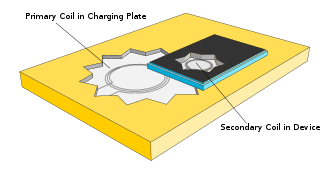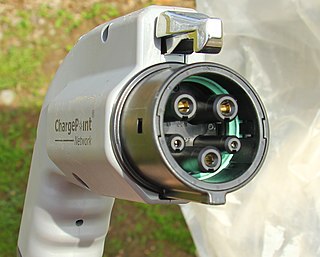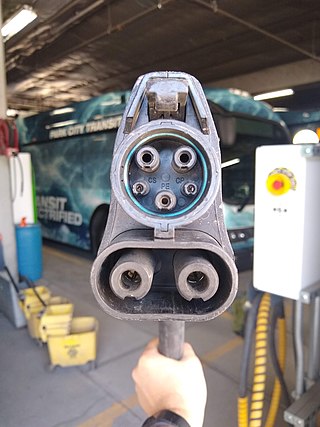
Arduino is an Italian open-source hardware and software company, project, and user community that designs and manufactures single-board microcontrollers and microcontroller kits for building digital devices. Its hardware products are licensed under a CC BY-SA license, while the software is licensed under the GNU Lesser General Public License (LGPL) or the GNU General Public License (GPL), permitting the manufacture of Arduino boards and software distribution by anyone. Arduino boards are available commercially from the official website or through authorized distributors.
Avcon is a company that manufactures charging interfaces for battery electric vehicles (EV). The lettering convention is Avcon for the company and AVCON (capitals) for the EV charging connector.

Inductive charging is a type of wireless power transfer. It uses electromagnetic induction to provide electricity to portable devices. Inductive charging is also used in vehicles, power tools, electric toothbrushes, and medical devices. The portable equipment can be placed near a charging station or inductive pad without needing to be precisely aligned or make electrical contact with a dock or plug.

A charging station, also known as a charge point, chargepoint, or electric vehicle supply equipment (EVSE), is a power supply device that supplies electrical power for recharging plug-in electric vehicles.

Magne Charge is an obsolete inductive charging system used to charge battery electric vehicles (BEVs).

An electric vehicle charging network is an infrastructure system of charging stations to recharge electric vehicles. The term electric vehicle infrastructure (EVI) may refer to charging stations in general or the network of charging stations across a nation or region. The proliferation of charging stations can be driven by charging station providers or government investment, and is a key influence on consumer behaviour in the transition from internal combustion engine vehicles to electric vehicles. While charging network vendors have in the past offered proprietary solutions limited to specific manufacturers, vendors now usually supply energy to electric vehicles regardless of manufacturer.
ChargePoint is an American electric vehicle infrastructure company based in Campbell, California. ChargePoint operates the largest online network of independently owned EV charging stations operating in 14 countries and makes some of its technology.

SAE J1772, also known as a J plug or Type 1 connector after its international standard, IEC 62196 Type 1, is a North American standard for electrical connectors for electric vehicles maintained by SAE International under the formal title "SAE Surface Vehicle Recommended Practice J1772, SAE Electric Vehicle Conductive Charge Coupler".
Plugless Power is a family of Electric Vehicle Supply Equipment (EVSE) products manufactured by Plugless Power, Inc. that enable wireless (inductive) charging for electric vehicles (WCEV). The Plugless Power EVSE wirelessly delivers electrical power to the on-board EV battery charger using electromagnetic induction without a physical connection (cable) to the vehicle. An EV equipped with a Plugless Vehicle Adapter can be charged by parking it over an inductive Plugless Parking Pad. The active step of plugging a cord into the vehicle is eliminated.

CHAdeMO is a fast-charging system for battery electric vehicles, developed in 2010 by the CHAdeMO Association, formed by the Tokyo Electric Power Company and five major Japanese automakers. The name is an abbreviation of "CHArge de MOve" and is derived from the Japanese phrase "o CHA deMO ikaga desuka" (お茶でもいかがですか), translating to English as "How about a cup of tea?", referring to the time it would take to charge a car.

IEC 62196Plugs, socket-outlets, vehicle connectors and vehicle inlets – Conductive charging of electric vehicles is a series of international standards that define requirements and tests for plugs, socket-outlets, vehicle connectors and vehicle inlets for conductive charging of electric vehicles and is maintained by the technical subcommittee SC 23H “Plugs, Socket-outlets and Couplers for industrial and similar applications, and for Electric Vehicles” of the International Electrotechnical Commission (IEC).
The Open Charge Point Protocol (OCPP) is an application protocol for communication between Electric vehicle (EV) charging stations and a central management system, also known as a charging station network, similar to cell phones and cell phone networks. The original version was written by Joury de Reuver and Franc Buve.

The Combined Charging System (CCS) is a standard for charging electric vehicles. It can use Combo 1 (CCS1) or Combo 2 (CCS2) connectors to provide power at up to 350 kilowatts (kW) . These two connectors are extensions of the IEC 62196 Type 1 and Type 2 connectors, with two additional direct current (DC) contacts to allow high-power DC fast charging. In response to demand for faster charging, 400 kW CCS chargers have been deployed by charging networks and 700 kW CCS chargers have been demonstrated.

The IEC 62196 Type 2 connector is used for charging electric vehicles, mainly within Europe, as it was declared standard by the EU. Based on widespread red IEC 60309 three phase plugs with five pins, which come in different diameters according to maximum current, a single size was selected, as maximum possible power will be communicated to the car via two additional communication pins and by a simple resistor coding within the cable. The onboard charger inside the car has to limit the current accordingly.
EVBox is an electric vehicle supply equipment company based in Amsterdam, Netherlands. Founded in 2010 by Bram van der Leur and Huub Rothengatter, it currently has 13 offices around the world, including Amsterdam, Antwerp, Bordeaux, Copenhagen, Libertyville, Madrid, Milton Keynes, Munich, New York City, Oslo, Paris, Rotterdam, and Warsaw. EVBox manufactures and distributes electric vehicle (EV) charging stations and charging management software. As of December 2020, it has a global installed base of over 190,000 charging points.

SAE J3068 "Electric Vehicle Power Transfer System Using a Three-Phase Capable Coupler" is a North American recommended practice published and maintained by SAE International. J3068 defines electrical connectors and a control protocol for electric vehicles. It has the formal title "SAE Surface Vehicle Recommended Practice J3068". J3068 defines a system of conductive power transfer to an electric vehicle using a coupler capable of transferring single-phase and three-phase AC power as well as DC power, and defines a digital communication system for control. J3068 also specifies requirements for the vehicle inlet, supply equipment connector, mating housings and contacts.
The GB/T charging standard is a set of GB/T standards, primarily in the GB/T 20234 family, for electric vehicle AC and DC fast charging used in China. The standards were revised and updated most recently in 2015 by the Standardization Administration of China. The term is an abbreviation of 国标推荐 (guóbiāo/tuījiàn), translated as "recommended/voluntary national standard".

The ChaoJi connector, also referenced as CHAdeMO 3.0, is an ultra-high-power charging standard charging electric cars, released in 2020. The connector has a lemniscate shape (∞), with a flat bottom edge and is planned for charging battery electric vehicles at up to 900 kilowatts using direct current. The design incorporates backward compatibility with CHAdeMO and the GB/T DC-charging, using a dedicated inlet adapter for each system. The circuit interface of ChaoJi is also designed to be fully compatible with the Combined Charging System, also known as CCS.

The IEC 62196 Type 3 connector is used for charging battery electric vehicles, mainly within France and Italy, as it was one of three AC plug standards described in IEC 62196-2. The Type 3 connector comes in two physical formats, Type 3A for single-phase (230V) and Type 3C for single- and three-phase (400V) alternating current (AC) power. Both have since been superseded by the Type 2 connector, the latter adopted as sole connector in 2013 by the European Union. The Type 1 connector is the corresponding AC connector standard used in North America, Japan, and South Korea.











